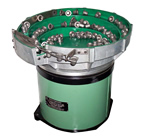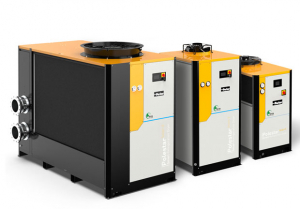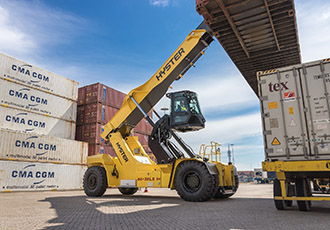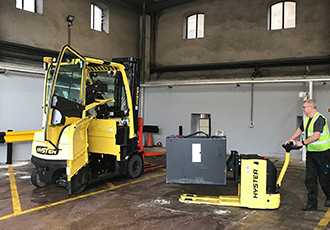White paper on bowl selection for a vibratory bowl feeder
7th January 2008
Source:
Elscint Automation

Vibratory bowls can be made in a variety of material like cast aluminium, mild steel, stainless steel, polyamide, etc. Each of these materials has certain advantages as well as disadvantages. Bowls made of mild steel are not long lasting due to rusting and not so wear resistance. Over time, their performance deteriorates drastically. Aesthetic wise too, it does not look good. Hence, it is not recommended to select mild steel bowls.
Polyamide bowls have certain advantages like machining ease and repeatability but the disadvantages are the size (small) and type (conical). Step design bowls, which provide a lot of tooling flexibility, convenience and high loading volumes are not always possible in case of polyamide bowls. These disadvantages are not there in stainless steel and cast aluminum bowls. The advantages of these types of bowls are tooling flexibility, convenience and high loading volume. Secondly, it is possible to provide irregular and complicated bowl tooling and shapes in case of stainless steel fabricated bowls. However, the biggest advantage of stainless steel bowls is the tooling flexibility they provide. But these are costly as compared to cast aluminum bowls.
The advantages of using cast aluminum bowls are the ease and speed of tooling and lower cost. However, proper coating is required for all cast aluminum bowls. Elscinthane spray able polyurethane coating is the best choice for cast aluminum and stainless steel bowls.
Not only does the coating reduce the noise level in case of metallic components drastically by eliminating the metal to metal contact, but the life and performance of the bowl improves drastically. The Elscinthane bowl linings are available in various thicknesses ranging from 0.40 mm to even upto 2 mm and above. Elscinthane spray able polyurethane coatings have very high shore hardness and this increases the life of the Bowl tremendously. In case of stainless steel bowls, cylindrical bowls are possible but they have a lot of disadvantages like jamming of components between the track, less area for tooling, low loading capacity etc.
Another possibility in case of stainless steel is outer track bowls. These are costlier to make but have a lot of inherent advantages like high loading capacity, optimum area for tooling. In case there is a requirement for high speed and complicated orientation, then outer track bowl is the only solution. However, the disadvantage is the high cost of such bowls.
The time taken for making such bowls too is more. Selection of the right type of material and shape for a bowl feeder has repercussions on the continuous maintenance free working of the bowl feeder in the long run and hence the proper material and shape of the bowl is very important. Before ordering a bowl feeder, the customer should discuss with the bowl feeder manufacturer about the shape and the material he has planned for the bowl and the reasons for the same.
Though these are usually the prerogative of the bowl feeder manufacturer, the customer, being the user of the bowl, should try to get the reasons behind the same. Secondly, while selecting the type of material and shape for a bowl feeder, one should check whether the bowl feeder manufacturer has the required coating expertise and technology, otherwise, the life of the bowl reduces and feeding too becomes problematic and erratic.
The advantages of using cast aluminum bowls are the ease and speed of tooling and lower cost. However, proper coating is required for all cast aluminum bowls. Elscinthane spray able polyurethane coating is the best choice for cast aluminum and stainless steel bowls.
Not only does the coating reduce the noise level in case of metallic components drastically by eliminating the metal to metal contact, but the life and performance of the bowl improves drastically. The Elscinthane bowl linings are available in various thicknesses ranging from 0.40 mm to even upto 2 mm and above. Elscinthane spray able polyurethane coatings have very high shore hardness and this increases the life of the Bowl tremendously. In case of stainless steel bowls, cylindrical bowls are possible but they have a lot of disadvantages like jamming of components between the track, less area for tooling, low loading capacity etc.
Another possibility in case of stainless steel is outer track bowls. These are costlier to make but have a lot of inherent advantages like high loading capacity, optimum area for tooling. In case there is a requirement for high speed and complicated orientation, then outer track bowl is the only solution. However, the disadvantage is the high cost of such bowls.
The time taken for making such bowls too is more. Selection of the right type of material and shape for a bowl feeder has repercussions on the continuous maintenance free working of the bowl feeder in the long run and hence the proper material and shape of the bowl is very important. Before ordering a bowl feeder, the customer should discuss with the bowl feeder manufacturer about the shape and the material he has planned for the bowl and the reasons for the same.
Though these are usually the prerogative of the bowl feeder manufacturer, the customer, being the user of the bowl, should try to get the reasons behind the same. Secondly, while selecting the type of material and shape for a bowl feeder, one should check whether the bowl feeder manufacturer has the required coating expertise and technology, otherwise, the life of the bowl reduces and feeding too becomes problematic and erratic.
Similar articles
More from Elscint Automation
- Elscint Vibratory Bowl Feeder for feeding Camphor Tablets 22nd April 2013
- Elscint Vibratory Bowl Feeder for feeding small Pins 19th February 2013
- Elscint Rotary / Centrifugal Feeder 11th February 2013
- Vibratory Drive for Bausch + Stroebel bowl 30th October 2012




.jpg)







Write a comment
No comments